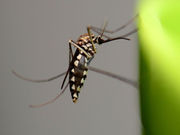Yellow fever has potential to be fifth mosquito-borne infection to appear in U.S. since 1990s
THURSDAY, March 9, 2017 (HealthDay News) — U.S. health officials are concerned about another potential mosquito-borne health threat to Americans — yellow fever, according to a perspective piece published online March 8 in the New England Journal of Medicine.
Catharine I. Paules, M.D., and Anthony S. Fauci, M.D., of the National Institute of Allergy and Infectious Diseases in Bethesda, Md., said that a large outbreak of yellow fever in Brazil must be closely monitored. According to the authors, yellow fever has the potential to be the fifth mosquito-borne infection to appear in the continental United States since the 1990s, following dengue, West Nile, chikungunya, and the Zika virus.
“Although it is highly unlikely that we will see yellow fever outbreaks in the continental United States where mosquito density is low and risk of exposure is limited, it is possible that travel-related cases of yellow fever could occur, with brief periods of local transmission in warmer regions such as the Gulf Coast states, where Aedes aegypti mosquitoes are prevalent,” the team said. To prevent the Brazil outbreak from spreading, “early identification of cases and rapid implementation of public health management and prevention strategies, such as mosquito control and appropriate vaccination, are critical,” Paules and Fauci write.
However, “early recognition may be difficult in countries such as the United States, where most physicians have never seen a case of yellow fever,” the authors point out. Early symptoms include a fever that can mimic flu, followed by a period of remission, and then a stage called “intoxication” — high fever, liver dysfunction and jaundice, and even kidney failure, heart and nervous system dysfunction, and shock.
Copyright © 2017 HealthDay. All rights reserved.








